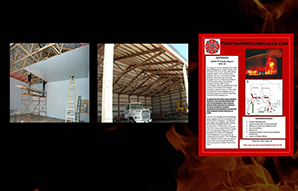Popular Firefighting News Forum Develops Training Poster based on NIOSH Fire Fighter Fatality Investigation Report
September 2019
DHHS (NIOSH) Publication Number 2019-167
A Story of Impact:

Image on left shows the installation of a pan ceiling (photo credit: Chief Brian Kazmierzak), the image in the center shows a commercial building without a pan ceiling (photo credit: NIOSH), and the poster on the far right was produced by Chief Billy Goldfeder
Hidden spaces that support the spread of fire can have devastating effects for firefighters who enter burning structures. In August 2014, one firefighter was killed and another was injured after a roof collapse that was likely due, in part, to a fire that was hidden by a pan ceiling. A pan ceiling is a metal ceiling that, in this case, covered wooden truss supports of a commercial storage unit. The space between the pan ceiling and roof created a room similar to an attic that supported the spread of the fire and burned the trusses, which ultimately caused the roof collapse.
To better understand this fire event, the National Institute for Occupational Safety and Health (NIOSH) Fire Fighter Fatality Investigation and Prevention Program (FFFIPP) conducted an investigation of the assistant fire chief ’s line-of-duty death. Rapid fire spread that was hidden by a pan ceiling was identified as a contributing factor in the collapse that killed the assistant chief. In addition to the pan ceiling in this incident hiding the fire, FFFIPP investigators identified other factors that contributed to the death of the assistant fire chief. These were the lack of an established incident command, break-down in communication, poor situational awareness, and no safety officer on scene.
As a result, NIOSH recommended that fire departments take the following steps to prevent similar deaths: identify a single incident commander, conduct a risk assessment, collaborate with neighboring fire departments to develop standard operating procedures, establish col-lapse zones, and designate a safety officer for structure fires.1
The NIOSH FFFIPP published a report detailing this fire event. The report includes contributing factors as well as recommendations to prevent similar deaths from occurring. To ensure that the information in the report got to the broader fire service community, key information from the report was featured on a training poster prepared by Firefighter Close Calls, a popular online firefighting news and update forum.
Based on this FFFIPP investigation report, Firefighter Close Calls, which gets about 1 million unique web visits each month, created and posted a 1-page poster for the fire service to display in their departments. This poster summarizes key information and contributing factors from this NIOSH FFFIPP report. Firefighter Close Calls also produces an e-newsletter called the Secret List, which is sent to about 400,000 subscribers. The poster was also sent to subscribers of the Secret List. Firefighter Close Calls intends to develop posters for future published NIOSH FFFIPP reports.2
- The overhead wooden truss supports were on fire and concealed by a pan ceiling.
- Incident command was not aware that firefighters were in the structure.
- Fire departments need to be aware of the potential hazards of pan ceilings and adjust firefighting tactics.
- The news forum Firefighter Close Calls developed a 1-page poster highlighting the NIOSH FFFIPP report findings.2
View/Download Entire Document: Popular Firefighting News Forum Develops Training Poster based on NIOSH Fire Fighter Fatality Investigation Report [PDF – 327 KB]
![]()
![]()

![]()
Get More Information
Find NIOSH products and get answers to workplace safety and health questions:
1-800-CDC-INFO (1-800-232-4636) | TTY: 1-888-232-6348
CDC/NIOSH INFO: cdc.gov/info | cdc.gov/niosh
Monthly NIOSH eNews: cdc.gov/niosh/eNews
References
- NIOSH [2018]. Death in the line of duty. By Miles, S, Loflin, M. Morgantown, WV: U.S. Department of Health and Human Services, Centers for Disease and Control Preventions, National Institute for Occupational Safety and Health, DHHS (NIOSH) Publication 2014-18, https://www.cdc.gov/niosh/fire/pdfs/face201418.pdf.
- Goldfeder, B. [2018]. NIOSH ff fatality report 2014-18. Poster. https://www.firefighterclosecalls.com/niosh-lessons-learned/
Suggested Citation
NIOSH [2019]. A Story of Impact: Popular Firefighting News Forum Develops Training Poster based on NIOSH Fire Fighter Fatality Investigation Report. By Miles S, Wilson KJ, and Webb S. Morgantown, WV: U.S. Department of Health and Human Services, Centers for Disease Control and Prevention, National Institute for Occupational Safety and Health, DHHS (NIOSH) Publication 2019–167. DOI: https://doi.org/10.26616/NIOSHPUB2019167
